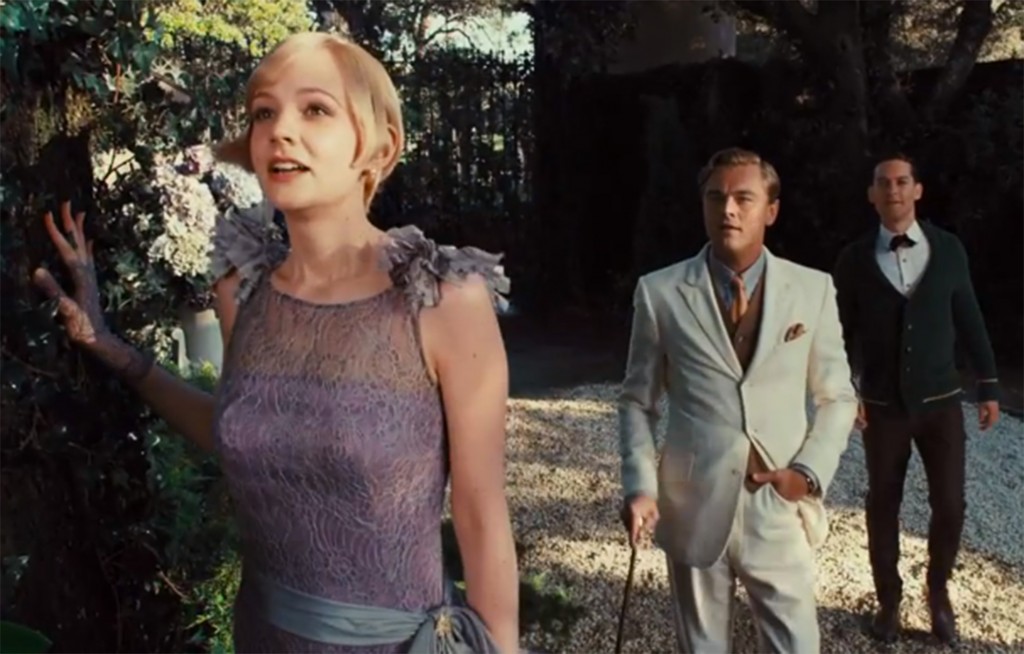
Let’s start with director Baz Luhrman’s decision to present The Great Gatsby in 3D. The source material, F. Scott Fitzgerald’s novel, is so compelling because it is character driven. Luhrman’s 3D cannot enhance the characters, but can only augment wild car chases and zooming camera shots that zip us down skyscrapers and across bays. So to use Gatsby as an excuse to launch some action sequences really misses the point of the story. See The Movie Gourmet’s Ten Really Bad Movie Ideas.
Indeed, there’s lots of eye candy in Luhrman’s Gatsby, but to what effect? The story seems set, not in the 1920s, but in a modern 1920s theme park where tourists waddle around chomping on churros while peering at flappers and Duesenbergs.
The story is about the Coolest Man in the World, the impenetrable Jay Gatsby, whose savoir faire, personal mystery and lifestyle splendor completely seduce his neighbor Nick Carraway, the story’s narrator. Now you would think that putting Leonard DiCaprio in impeccably styled white and pastel pink suits would take you a long way toward Cool. But this Gatsby is a little too anxious. And the screenplay dumbs down the story, and we learn too much about Gatsby’s real past too early and too easily. Similarly, Tobey Maguire as Carraway brings a yippy dog energy to a character that should be more observant (like Sam Waterston’s laconic Nick in the 1974 Gatsby).
Gatsby, the acme of the self-made, is driven to at long last possess Daisy (Carey Mulligan), the girl who got away (and who is now married to the boorish jock Tom Buchanan). The novel deeply explores Gatsby’s pursuit of Daisy. Can someone with New Money penetrate the Old Money set? Did Daisy really love Gatsby when they were younger, or was he just a girlish flirtation? Does Daisy love Gatsby now, or is she just flattered by his captivation and impressed by his bling? Can Daisy escape her class? Can Gatsby’s success buy him everything that he needs and wants?
Sadly, Luhrman reduces The Great Gatsby into a sappy melodrama of obsessive love. That’s kind of like turning The Sun Also Rises into a bullfight story or The Adventures of Huckleberry Finn into a river raft travelogue. It doesn’t help that Carey Mulligan’s Daisy is more neurotic than fickle – and just not that sexually fascinating to begin with.
The one good thing about this movie is Elizabeth Debicki’s turn as the celebrity golfer and jaded party girl Jordan Baker – her every glance commands the screen.
Luhrman made lots of other choices in this adaptation. Some work out (to my surprise, I didn’t mind the 21st century music) and some don’t (the odd and nakedly commercial casting of Bollywood star Amitabh Bachchan as Meyer Wolfsheim). But the resulting totality is a hollow, somewhat vulgar misfire. It’s the flashiest version of The Great Gatsby, but strangely not even as vivid as the written word.
In the novel, Daisy and Tom Buchanan are “careless” people – their Old Money has insulated them from the consequences of their selfishness and irresponsibility. Fitzgerald describes them thus:
Let me tell you about the very rich. They are different from you and me. They possess and enjoy early, and it does something to them, makes them soft where we are hard, and cynical where we are trustful, in a way that, unless you were born rich, it is very difficult to understand. They think, deep in their hearts, that they are better than we are because we had to discover the compensations and refuges of life for ourselves. Even when they enter deep into our world or sink below us, they still think that they are better than we are. They are different.
The Great Gatsby is almost 2 1/2 hours long. That means about four hours of your life, if you count driving to the theater, parking, buying popcorn beforehand and returning home afterward. The novel is only 192 pages, so I strongly suggest that you take the four hours and read the glorious book instead.
